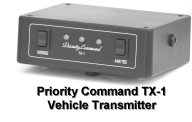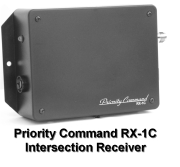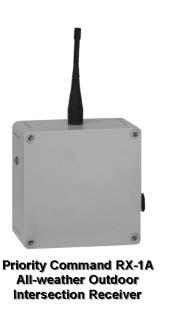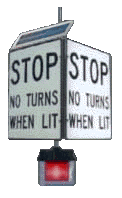Intelligent
design, quality construction, and innovative software make Priority Command the
best value in emergency traffic signal preemption available today.
Transmitter
 The
Priority Command vehicle
transmitter installs quickly and easily in any emergency vehicle
using standard mobile radio mounting hardware. No calibration
is required; just set one DIP switch for the vehicle's priority
level, and it's plug and play.
The
Priority Command vehicle
transmitter installs quickly and easily in any emergency vehicle
using standard mobile radio mounting hardware. No calibration
is required; just set one DIP switch for the vehicle's priority
level, and it's plug and play.
The transmitter is activated
whenever the vehicle's lightbar is in use. It uses 12-channel
WAAS-enabled GPS to track the vehicle's location, speed, and
heading. This information is encrypted and then transmitted using
proven, reliable 900 MHz spread spectrum frequency-shift-keyed
digital data radio.
Drivers have two large tactile-click
rocker switches—one to activate or deactivate the transmission
regardless of whether the lightbar is in use, and a second switch
to select extended-range four-way-red preemption. This feature
is primarily intended for police pursuits. When activated, it
signals the intersection receiver to increase the preemption
distance by 50% and to turn the traffic signals red in all directions.
One bicolor red-green LED indicates
power and the status of the GPS signal; a green LED blinks whenever
the unit is transmitting; and a red LED blinks whenever 4-way-red
preemption is enabled.
Features
- Rugged ABS polymer case
- Installs quickly and easily
in any vehicle—no complicated setup or calibration
- 12-channel WAAS-enabled GPS
for accuracy
- Automatic hands-free operation
- Around-the-corner preemption—not
limited to line of site
- Secure encrypted data to prevent
unauthorized use
- 6 priority levels—4 high-priority
and 2 low-priority
- Large, easy-to-operate switches
- Override On/Off switch
- Extended-range four-way-red
selector switch
- Clear LED indicators
- Transmitter status
- GPS status
- 4-way-red status
Specifications
| Case |
|
| Size: |
5"
x 3.5" x 1.5" |
| Material: |
High-impact
ABS polymer |
| Color: |
Black |
| Mounting
hardware |
Recessed
6mm x 1mm threaded brass insert on each side of case. Accommodates
machine screws (included) or quick-release knobs (optional). |
| Electronics |
|
| Electrical
connections |
Unswitched
+12–24 Vdc, 3 externally switched +12–24 Vdc (lightbar,
left- and right-turn signals), and ground |
| Electrical
connector |
Standard
DB-9M connector with jackscrews (6' DB-9F cable with thumbscrews
included) |
| GPS
receiver |
Internal,
12-channel, WAAS-enabled |
| GPS-WASS
accuracy |
3 meters
(~10') with 95% confidence |
| UHF
Transmitter |
900
MHz spread spectrum synthesized, frequency-shift-keyed |
| UHF
power |
200mW
maximum effective radiated power |
| Antenna
connectors |
GPS—SMA
UHF—TNC |
| Antennas
(sold separately) |
GPS—50
ohm, 3.3 Vdc biased
UHF—50 ohm
Numerous configurations available including dual-band integrated. |
| Antenna
mounts (sold separately) |
Numerous
options available including through-hole, bracket, trunk-lip,
magnetic, and adhesive mounts. |
Receivers
 The
Priority Command cabinet-mount intersection receiver
installs inside the traffic signal controller cabinet. It can
be secured to any flat surface in any orientation with two screws
(recommended) or adhesive. It connects directly to the preemption
inputs on most computer signal controllers. The external antenna
can be installed using a through-hole surface mount in the top
of the cabinet (recommended), adhesive, or a bracket mount. It
is powered by a commonly available 12 Vdc wall cube adapter (included).
The
Priority Command cabinet-mount intersection receiver
installs inside the traffic signal controller cabinet. It can
be secured to any flat surface in any orientation with two screws
(recommended) or adhesive. It connects directly to the preemption
inputs on most computer signal controllers. The external antenna
can be installed using a through-hole surface mount in the top
of the cabinet (recommended), adhesive, or a bracket mount. It
is powered by a commonly available 12 Vdc wall cube adapter (included).
Setup requires two simple steps.
First is to set the DIP switches inside the case according to
a chart
for the intersection size, roadway speed limit, and yellow light
time, and to enable or disable low-priority, 4-way-red, and around-the-corner
preemptions. Second is to save the GPS coordinates for the center
of the intersection from a Priority
Command transmitter-equipped
vehicle.
The Priority Command intersection receiver decrypts and processes GPS
data from vehicles using innovative software to track the vehicle's
position, speed, and heading and determine its authenticity and
priority level. When the vehicle reaches the optimum distance
from the intersection, the receiver closes one of four relays—depending
on the vehicle's direction of approach—which in turn activates
one of four directional preemption programs in the computer traffic
signal controller. The signal controller immediately turns all
green lights to yellow and then to red for all directions of
approach except that of the emergency vehicle which is kept green
or turned to green as soon as all other lights have turned to
red. The signal controller
may also be programmed to turn the lights red in all directions.
The Priority Command intersection receiver can distinguish among six
different priority levels—four high and two low. The four
high priority levels may be assigned as:
1. Heavy fire trucks (ladders,
pumpers, tankers)
2. Ambulances and rescue trucks
3. Police cruisers
4. Chiefs' cars and prisoner transports
The two low priority levels can
be assigned as:
5. Express busses, snowplows,
tow trucks (on police call)
6. Local busses
In case two or more vehicles
approach the same intersection from different directions, the
highest priority vehicle will get the preemption, even if a lower-priority
vehicle has already initiated a preemption from another direction.
The Priority Command intersection receiver responds to an extended-range
four-way-red preemption command from a vehicle by first increasing
the preemption distance by 50%, and then, when the vehicle reaches
that distance, closing a fifth relay. This causes the signal
controller to change all green lights to yellow and then red
in all directions.
The signal controller is programmed
so that preemptions always includes a normal yellow-light cycle.
The preemption remains in effect until the emergency vehicle
reaches the intersection. The preemption will also be canceled
if the vehicle stops, moves away from the intersection, or stops
transmitting.
Features
- Installs quickly and easily
inside the traffic signal controller cabinet.
- Uses commonly available 12 Vdc
power adapter (included).
- Connects directly to computer
traffic signal controller.
- Six preemption outputs: four
for directional green, one for four-way-red, and one reserved
for railroad preemption or custom-programmed, e.g., 5-way, intersections.
- Selectable around-the-corner
preemption
- Antenna options include through-hole
surface mount in top of cabinet (recommend), adhesive, or bracket
mount.
- Requires only two quick steps
to configure for an intersection:
- Set the DIP switches according
to a chart
for intersection size, roadway speed limit, and yellow light
time, and to enable or disable around-the-corner, 4-way red,
and low-priority preemptions.
- Store the GPS coordinates for
the center of the intersection.
- Non-volatile flash memory retains
configuration data through power outages.
- Recovers in seconds after power
is restored—no backup power required.
- LED status indicator.
Specifications
| Case |
|
| Size: |
5"
x 3.5" x 1.5" plus 0.5" mounting flanges |
| Material: |
High-impact
injection molded ABS polymer |
| Color: |
Black |
| Mounting
hardware |
Flanges
on back of case mount to any flat surface. |
| Electronics |
|
| UHF
Receiver |
900
MHz spread spectrum synthesized frequency-shift-keyed |
| Electrical
connections |
+12–24
Vdc, electrical ground, 6 preemption outputs, and logic common
(not shared with electrical ground). |
| Electrical
connector |
Standard DB-9M serial connector
with jackscrews and 6' DB-9F cable with thumbscrews included
with RX 1-C
(Waterproof connector and cable
with locking ring included with RX-1A)
|
| Antenna |
50 ohm external (sold separately
with RX-1C)
(Water-resistant "rubber
ducky" included with RX-1A)
|
| External
antenna mount (sold separately) |
Through-hole,
bracket, magnetic, or adhesive |
| External
antenna connector |
TNC |
 The
Priority Command RX-1A all-weather, outdoor receiver
is identical in features and specifications to the RX-1C except
that it is enclosed in a heavy-duty polystyrene case that meets
NEMA 4X (IP-66) standards for water and dust resistance, and
it includes a water-resistant "rubber ducky" antenna.
It is designed to withstand the harshest weather conditions from
sub-zero cold to desert heat, as well as wind, rain, snow, and
ice.
The
Priority Command RX-1A all-weather, outdoor receiver
is identical in features and specifications to the RX-1C except
that it is enclosed in a heavy-duty polystyrene case that meets
NEMA 4X (IP-66) standards for water and dust resistance, and
it includes a water-resistant "rubber ducky" antenna.
It is designed to withstand the harshest weather conditions from
sub-zero cold to desert heat, as well as wind, rain, snow, and
ice.
The RX-1A is ideal for controlling
dedicated warning lights at uncontrolled intersections, driveways,
and crosswalks or wherever there is no cabinet in which to install
it. It operates on 12–24 Vdc that can be provided from a
number of sources. It can even use solar-charged batteries for
locations where electricity is unavailable.
 The
Priority Command RX-1A all-weather receiver combined
with our traffic warning sign and solar-powered halogen-strobe
beacon provides a complete wireless solution for remote installations.
Just set the DIP switches, locate the center of the intersection,
hang it up, and forget it. It uses commonly available motorcycle
or snowmobile batteries which can provide years of maintenance-free
service and can be replaced in minutes.
The
Priority Command RX-1A all-weather receiver combined
with our traffic warning sign and solar-powered halogen-strobe
beacon provides a complete wireless solution for remote installations.
Just set the DIP switches, locate the center of the intersection,
hang it up, and forget it. It uses commonly available motorcycle
or snowmobile batteries which can provide years of maintenance-free
service and can be replaced in minutes.
 Return
to top.
©2021
Return
to top.
©2021





